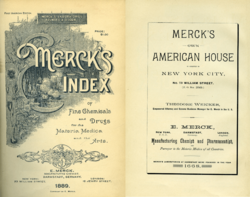History
The NFL edition of the Merck's Index was published in 1889 by the German chemical company Emanuel Merck and was primarily used as a sales catalog for Merck's growing list of chemicals it sold. [2] The American subsidiary was established two years later and continued to publish it. During World War I the US government seized Merck's US operations Merck & Co., forming a separate American company that continued to publish the Merck Index.
In 2012 the Merck Index was licensed to the Royal Society of Chemistry. [3] An online version of The Merck Index, including historic records and new updates not in the print edition, [1] is commonly available through research libraries. It also includes an appendix with monographs on organic named reactions.
The 15th edition was published in April 2013.
Monographs in The Merck Index typically contain: [1]
This page is based on this
Wikipedia article Text is available under the
CC BY-SA 4.0 license; additional terms may apply.
Images, videos and audio are available under their respective licenses.

